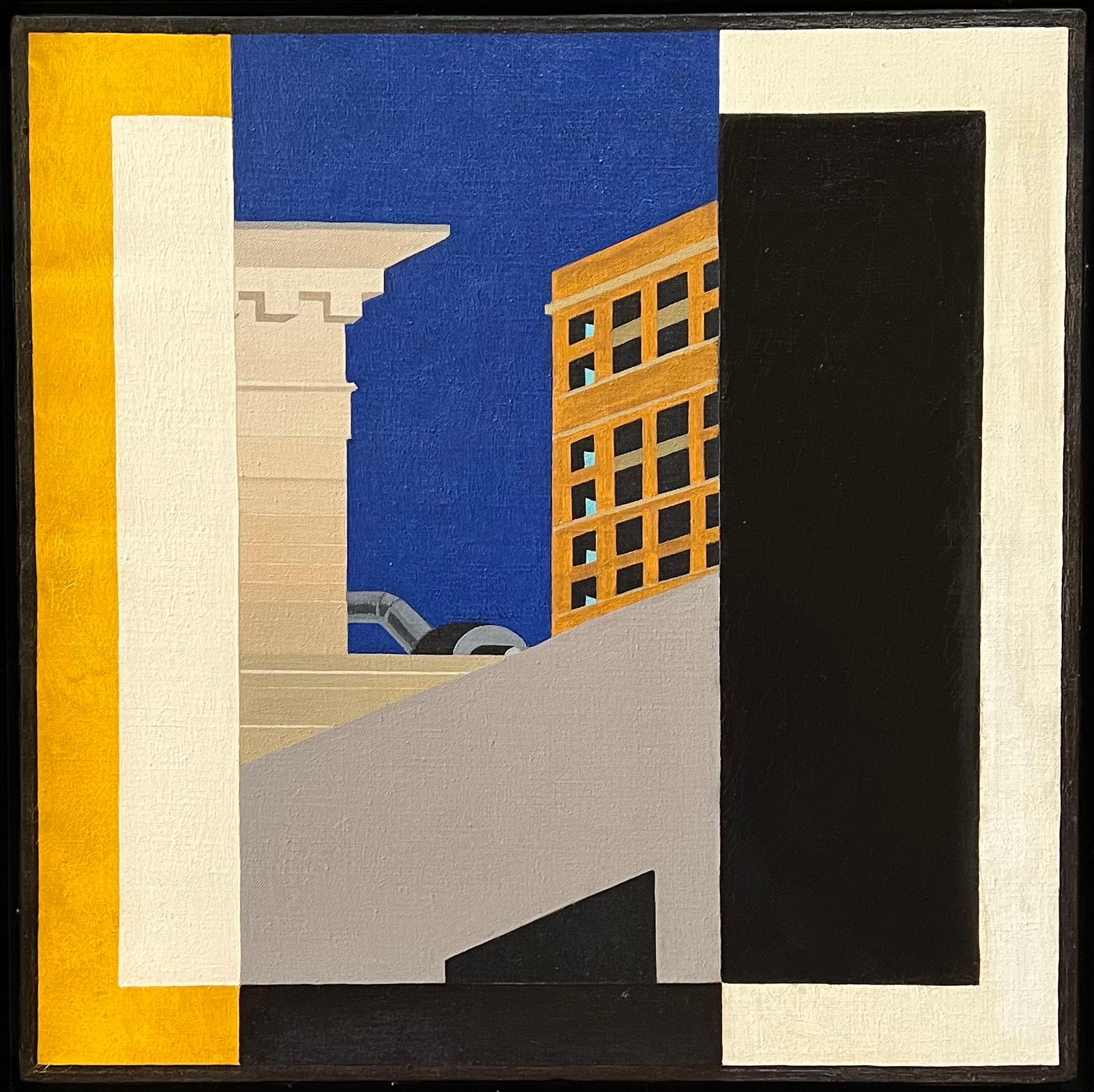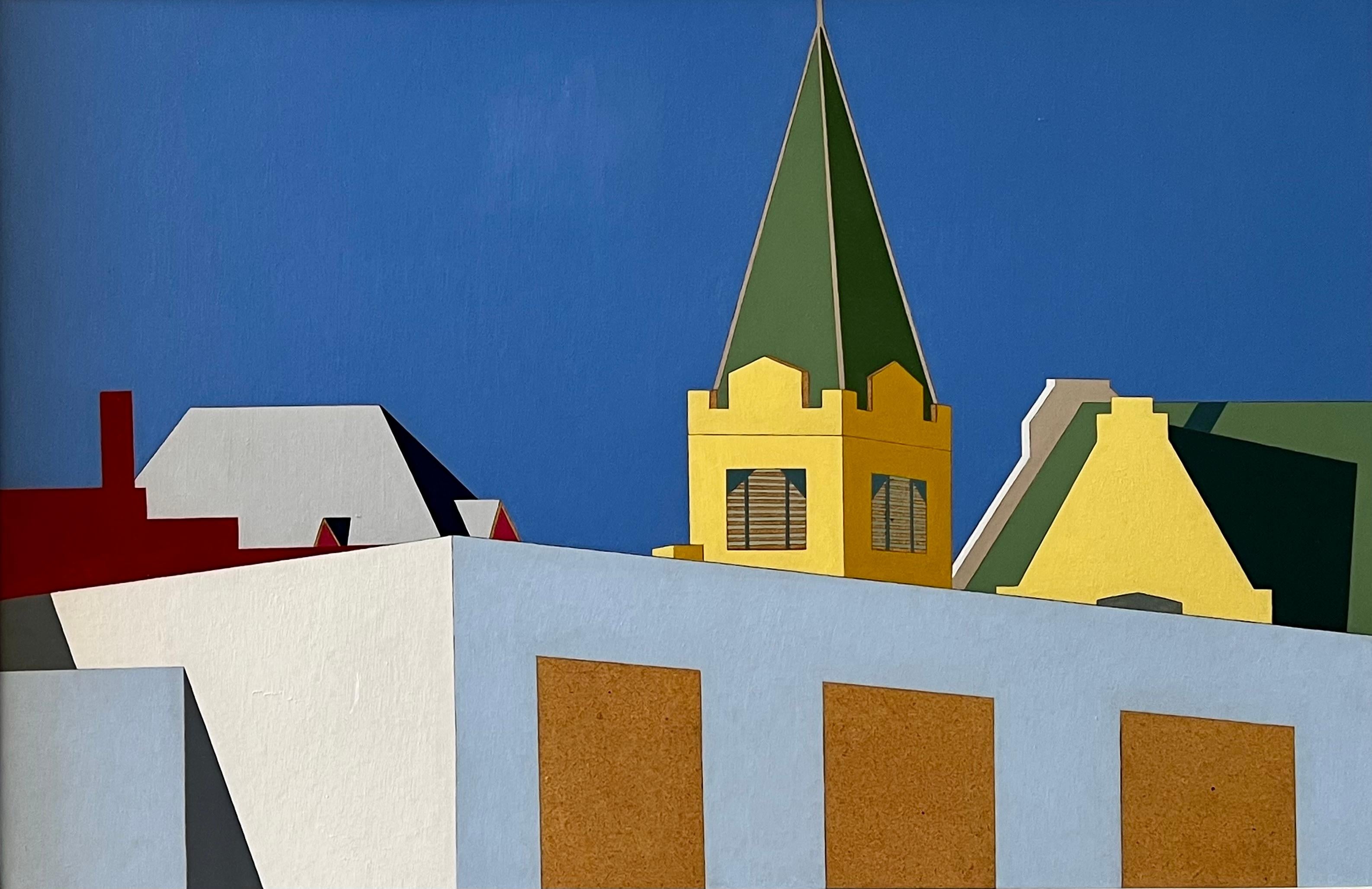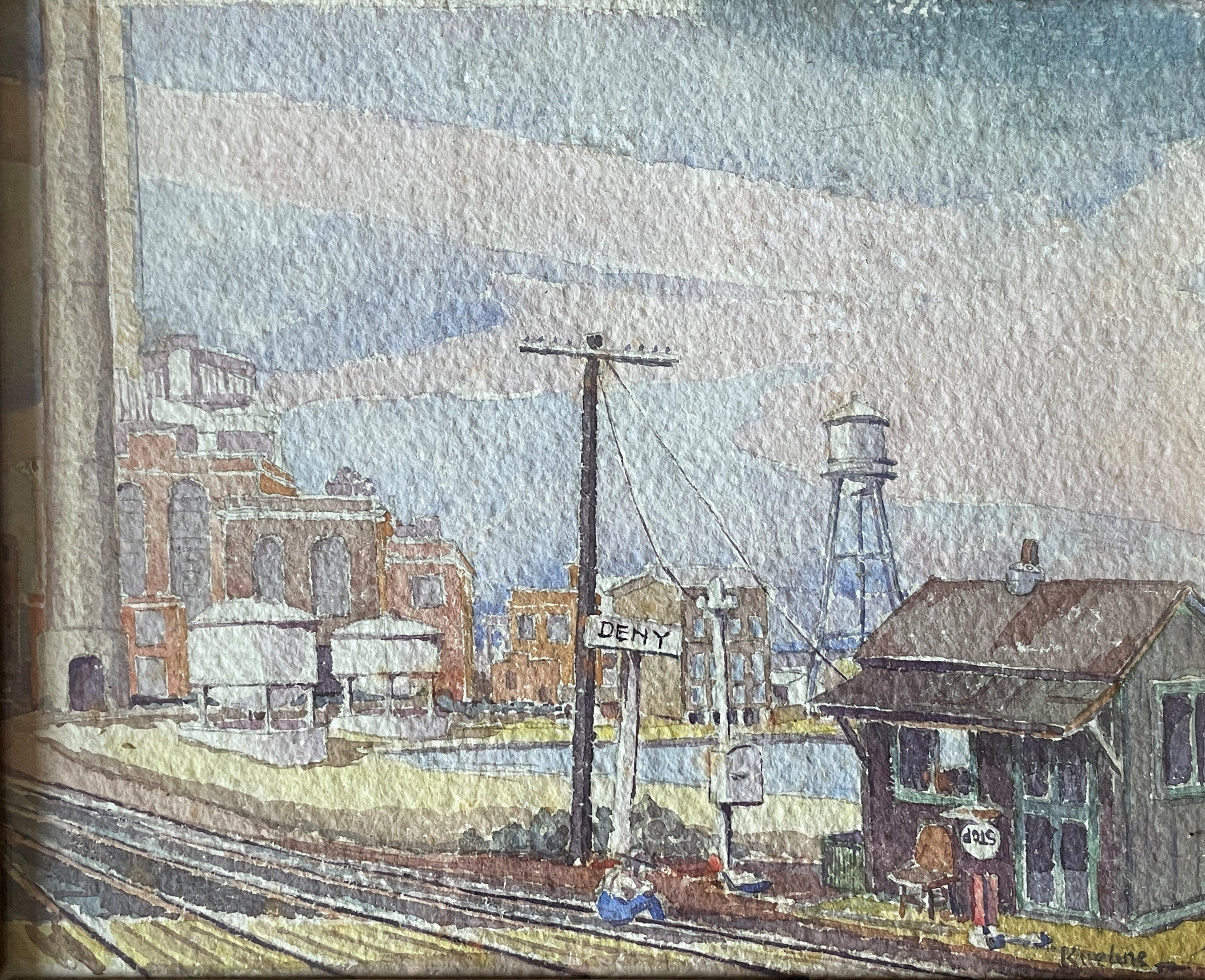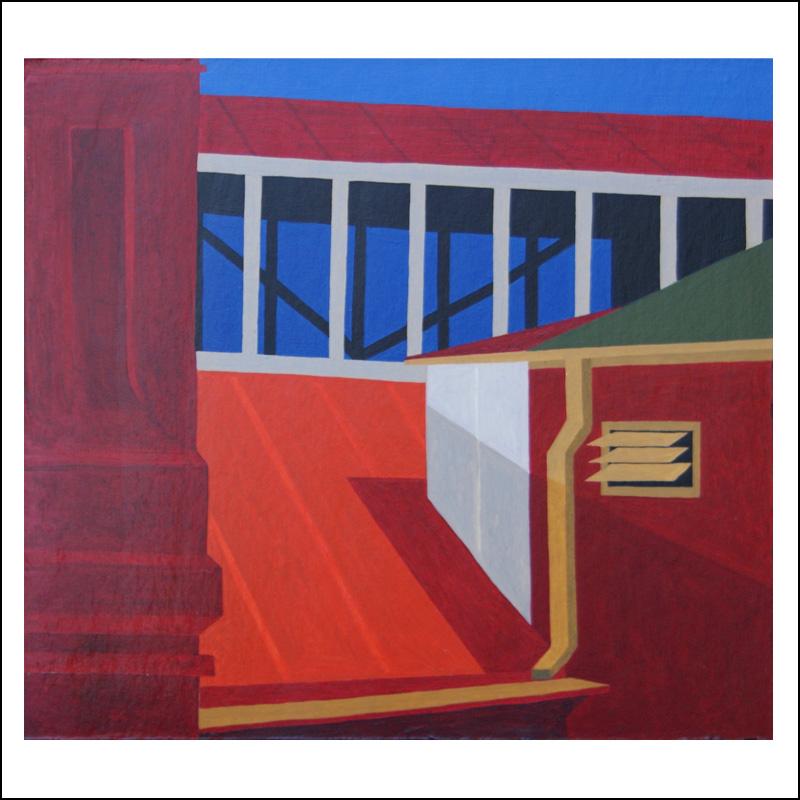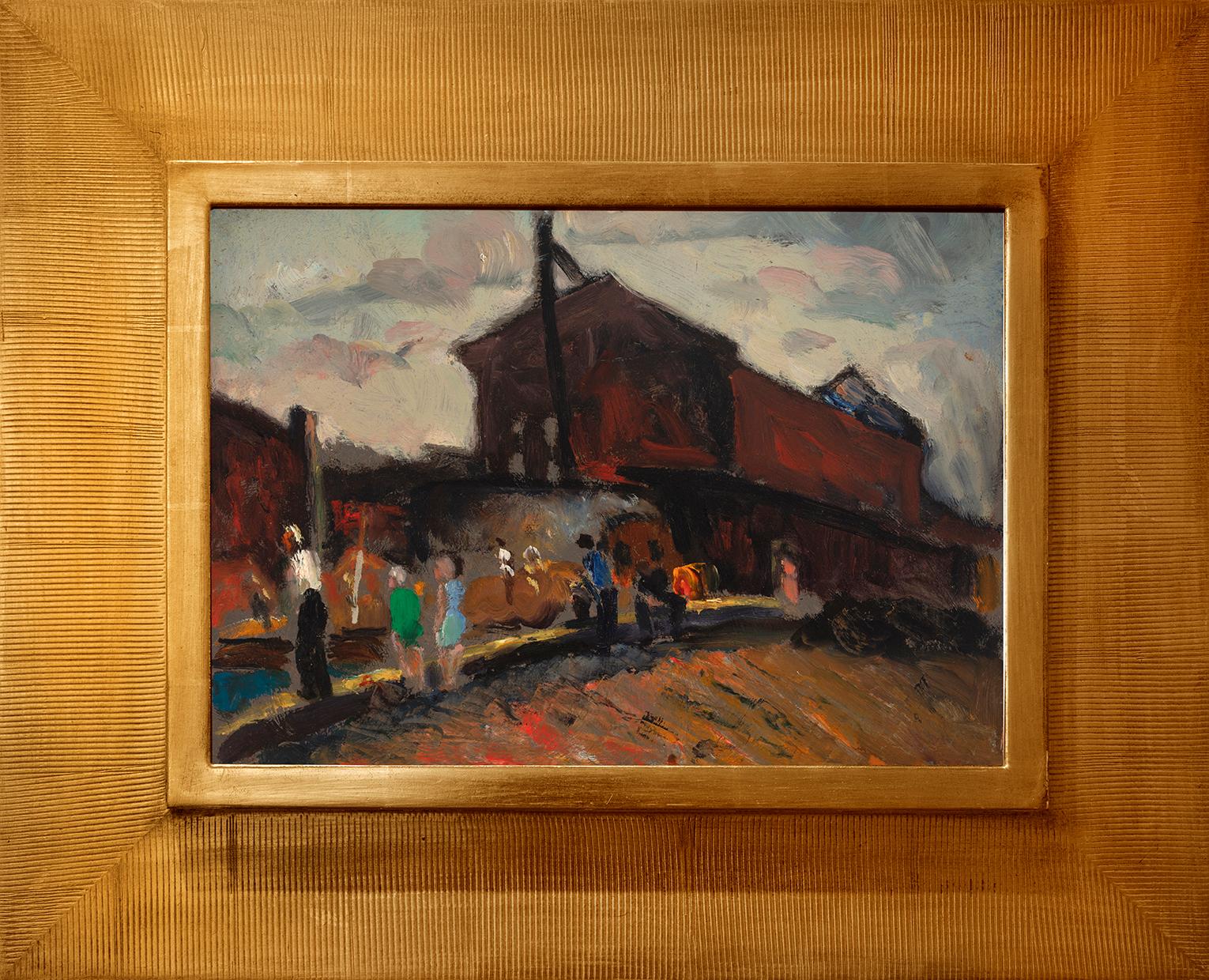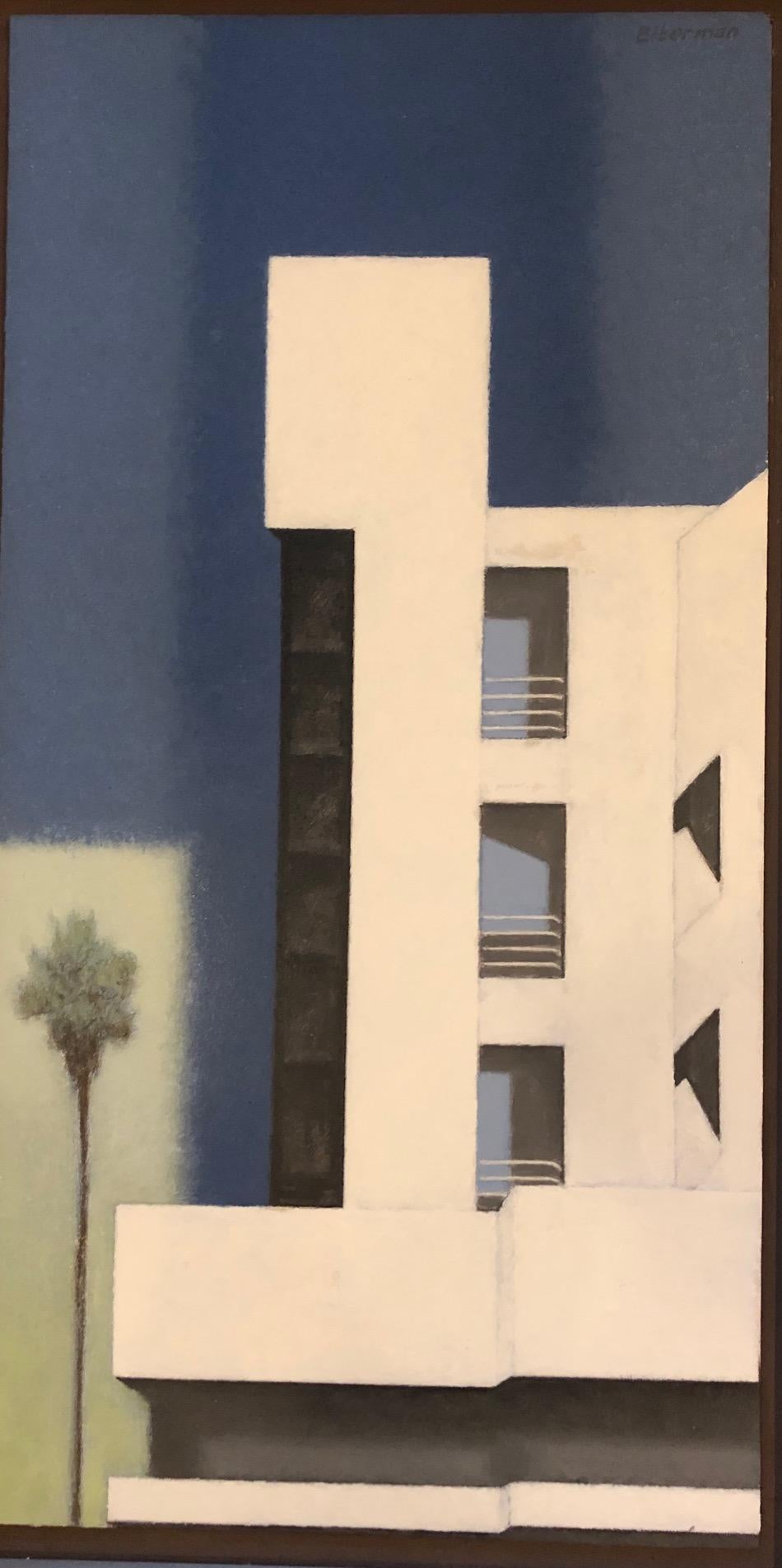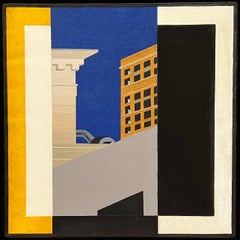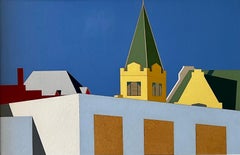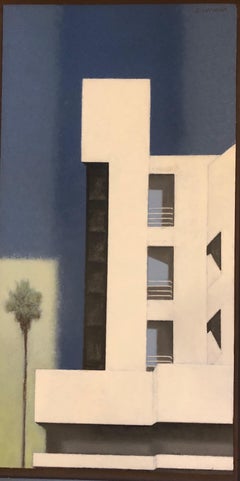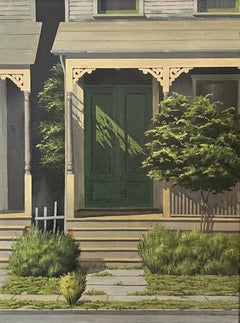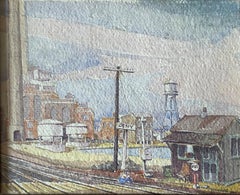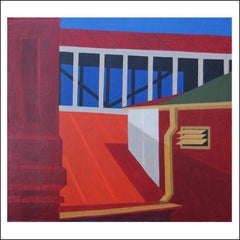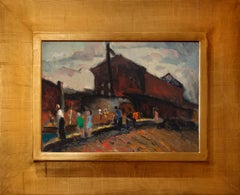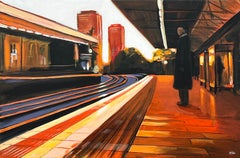Items Similar to The Railway Station
Want more images or videos?
Request additional images or videos from the seller
1 of 5
Edward BibermanThe Railway Stationc. 1934
c. 1934
$50,000
£37,733.63
€43,199.30
CA$70,516.58
A$77,418.41
CHF 40,389.35
MX$936,870.51
NOK 506,217.79
SEK 476,990.25
DKK 322,471.22
About the Item
The Railway Station, c. 1934, oil on canvas, signed lower right, titled verso and noted "34"; illustrated Kaufman, Jeffrey, Brush with Life: The Art of Being Edward Biberman (2007), 85 minutes (film)
This work is part of our exhibition The Architectural World of Edward Biberman (1904 - 1986).
About the Painting
The Railway Station is an important early work by Edward Biberman. It is a prime example of Biberman's precisionist and magic realism oriented paintings from the 1930s. Painted in New York, The Railway Station shows the artist's keen interest in urban architecture.
About the Artist
Edward Biberman was one of California’s most important modernist painters. He was born in Philadelphia, the son of Russian Jewish immigrants. Biberman’s artistic career started at the Pennsylvania Academy of Fine Arts followed by three years of study in Paris, where he associated closely with Calder and Noguchi and exhibited at the Salon d'Automne, Grand Palais, in 1927 and the Salon des Independents in 1929. Upon his return to the United States, Biberman spent time in New York City, where he showed at many of the city’s premier galleries and museums. His works were selected for several of the Museum of Modern Art’s early exhibitions of American artists, including 46 Painters and Sculptors Under the Age of 35 (1930) and Murals by American Painters and Photographers (1932). Hoping to escape the pressures of the New York art world, Biberman moved to Los Angeles in 1936 where he could be close to his family, including his film director brother, Herbert Biberman, and his sister-in-law, the Academy Award winning actress, Gale Sondergaard.
During the course of his long career, Biberman showed at the Salon d’Automne (Paris); the Whitney Museum of American Art; Metropolitan Museum of Art (New York), Corcoran Gallery, Los Angeles County Museum of Art (LACMA) and dozens of other museums and galleries across the US and in Europe. He enjoyed over forty-five solo exhibitions and his works were included in over one hundred group shows. Biberman completed three murals for public works projects, including his work Abbot Kinney and the Story of Venice for the Venice Post Office, which was installed for six months at LACMA in 2014. His works are in the permanent collections of more than a dozen museums, including the Museum of Fine Arts, Houston, National Portrait Gallery (of the Smithsonian Institution), Butler Institute of American Art, Pennsylvania Academy of Fine Arts and LACMA. Several books are dedicated to Biberman’s art, as is a feature length documentary, Brush with Life: The Art of Being Edward Biberman (2007). Biberman’s art has undergone a resurgence of popularity during the past fifteen years with four solo or focused exhibitions, Edward Biberman Revisited (2009), Edward Biberman (2011-12), Lost Horizons: Mural Dreams of Edward Biberman (2014) and Edward Biberman, Abbot Kinney and the Story of Venice (2014), and representation in a number of other exhibitions, such as George Ault and 1940s America at the Smithsonian Institution (2011), Pacific Standard Time (2012) and Contraption: Rediscovering California Jewish Artists (2018). He is listed in Who was Who in American Art and all other standard references. Biberman’s portrait of Martin Luther King, I Have a Dream, is currently on view at LACMA at part of Black American Portraits, a companion exhibition to the Obama presidential and first lady portraits.
Biberman’s brand of modernism can fairly be divided into four categories 1) precisionist urban scenes of New York and Southern California which celebrate the creations of humanity; 2) portraits which expose not only the historical context, but also the souls, of his subjects; 3) rural landscapes and still life paintings which portray the beauty of America and its flora; and 4) social realist works which explore the struggles, hopes and shortcomings of our society. Regardless of genre, Biberman had a unique sense of structure and color. His figures are at the same time specific and universal. Taken as a whole, Biberman’s body of work presents the viewer with a compelling and often daring vision of 20th century America and its art.
- Creator:Edward Biberman (1904 - 1986)
- Creation Year:c. 1934
- Dimensions:Height: 20 in (50.8 cm)Width: 30 in (76.2 cm)Depth: 1 in (2.54 cm)
- Medium:
- Movement & Style:
- Period:
- Condition:
- Gallery Location:Los Angeles, CA
- Reference Number:1stDibs: LU1859212202992
About the Seller
5.0
Vetted Professional Seller
Every seller passes strict standards for authenticity and reliability
1stDibs seller since 2022
17 sales on 1stDibs
Typical response time: <1 hour
- ShippingRetrieving quote...Shipping from: Los Angeles, CA
- Return Policy
Authenticity Guarantee
In the unlikely event there’s an issue with an item’s authenticity, contact us within 1 year for a full refund. DetailsMoney-Back Guarantee
If your item is not as described, is damaged in transit, or does not arrive, contact us within 7 days for a full refund. Details24-Hour Cancellation
You have a 24-hour grace period in which to reconsider your purchase, with no questions asked.Vetted Professional Sellers
Our world-class sellers must adhere to strict standards for service and quality, maintaining the integrity of our listings.Price-Match Guarantee
If you find that a seller listed the same item for a lower price elsewhere, we’ll match it.Trusted Global Delivery
Our best-in-class carrier network provides specialized shipping options worldwide, including custom delivery.More From This Seller
View AllView from Main Reading Room, New York
Located in Los Angeles, CA
View from Main Reading Room, New York, 1959-60, oil on canvas, signed and dated in pencil verso, 20 x 20 inches, exhibited: Cincinnati Art Galleries, Cincinnati, OH, March 4 to 28, 2...
Category
Mid-20th Century American Modern Landscape Paintings
Materials
Canvas, Oil
Pleasant Ridge
Located in Los Angeles, CA
Pleasant Ridge, 1966-7, oil on board, signed, dated and titled verso, 16 x 24 inches, exhibited: Robert Herrmann, Cincinnati Art Galleries, Cincinnati, OH, March 4 to 28, 2000, no. 1...
Category
Mid-20th Century American Modern Landscape Paintings
Materials
Masonite, Oil
Exterior Stairway
Located in Los Angeles, CA
Exterior Stairway, c. 1970s, oil on masonite, signed upper right, 12 x 24 inches; illustrated (film) Kaufman, Jeffrey, Brush with Life: The Art of Being Edward Biberman...
Category
Mid-20th Century American Modern Landscape Paintings
Materials
Oil
Price Upon Request
Across the Street
Located in Los Angeles, CA
This painting is part of our exhibition Charles Goeller: A Wistful Loneliness.
Oil on canvas, 16 x 12 inches, Signed lower right
Exhibited:
1) [Solo E...
Category
1940s American Modern Landscape Paintings
Materials
Oil, Canvas
Winged Victory of Los Angeles
Located in Los Angeles, CA
Winged Victory of Los Angeles, c. 1960, oil on masonite, signed lower right, artist’s name and title verso, 33 x 34 1/2 inches, exhibited: 1) Edward Biberman, Heritage Gallery, Los A...
Category
1960s American Modern Landscape Paintings
Materials
Masonite, Oil
Untitled (Houses and Railroad Tracks)
By Harry Lane
Located in Los Angeles, CA
Untitled (Houses and Railroad Tracks), c. 1940s, oil on canvas board, signed lower right, 16 x 20 inches, presented in a newer frame
This work is part of our exhibition America Coas...
Category
1940s American Modern Paintings
Materials
Oil, Board
You May Also Like
"Train Station, " Max Kuehne, Industrial City Scene, American Impressionism
By Max Kuehne
Located in New York, NY
Max Kuehne (1880 - 1968)
Train Station, circa 1910
Watercolor on paper
8 1/4 x 10 1/4 inches
Signed lower right
Provenance:
Private Collection, Illinois
Max Kuehne was born in Halle, Germany on November 7, 1880. During his adolescence the family immigrated to America and settled in Flushing, New York. As a young man, Max was active in rowing events, bicycle racing, swimming and sailing. After experimenting with various occupations, Kuehne decided to study art, which led him to William Merritt Chase's famous school in New York; he was trained by Chase himself, then by Kenneth Hayes Miller. Chase was at the peak of his career, and his portraits were especially in demand. Kuehne would have profited from Chase's invaluable lessons in technique, as well as his inspirational personality. Miller, only four years older than Kuehne, was another of the many artists to benefit from Chase's teachings. Even though Miller still would have been under the spell of Chase upon Kuehne's arrival, he was already experimenting with an aestheticism that went beyond Chase's realism and virtuosity of the brush. Later Miller developed a style dependent upon volumetric figures that recall Italian Renaissance prototypes.
Kuehne moved from Miller to Robert Henri in 1909. Rockwell Kent, who also studied under Chase, Miller, and Henri, expressed what he felt were their respective contributions: "As Chase had taught us to use our eyes, and Henri to enlist our hearts, Miller called on us to use our heads." (Rockwell Kent, It's Me O Lord: The Autobiography of Rockwell Kent. New York: Dodd, Mead and Co., 1955, p. 83). Henri prompted Kuehne to search out the unvarnished realities of urban living; a notable portion of Henri's stylistic formula was incorporated into his work.
Having received such a thorough foundation in art, Kuehne spent a year in Europe's major art museums to study techniques of the old masters. His son Richard named Ernest Lawson as one of Max Kuehne's European traveling companions. In 1911 Kuehne moved to New York where he maintained a studio and painted everyday scenes around him, using the rather Manet-like, dark palette of Henri.
A trip to Gloucester during the following summer engendered a brighter palette. In the words of Gallatin (1924, p. 60), during that summer Kuehne "executed some of his most successful pictures, paintings full of sunlight . . . revealing the fact that he was becoming a colorist of considerable distinction." Kuehne was away in England the year of the Armory Show (1913), where he worked on powerful, painterly seascapes on the rocky shores of Cornwall. Possibly inspired by Henri - who had discovered Madrid in 1900 then took classes there in 1906, 1908 and 1912 - Kuehne visited Spain in 1914; in all, he would spend three years there, maintaining a studio in Granada. He developed his own impressionism and a greater simplicity while in Spain, under the influence of the brilliant Mediterranean light. George Bellows convinced Kuehne to spend the summer of 1919 in Rockport, Maine (near Camden). The influence of Bellows was more than casual; he would have intensified Kuehne's commitment to paint life "in the raw" around him.
After another brief trip to Spain in 1920, Kuehne went to the other Rockport (Cape Ann, Massachusetts) where he was accepted as a member of the vigorous art colony, spearheaded by Aldro T. Hibbard. Rockport's picturesque ambiance fulfilled the needs of an artist-sailor: as a writer in the Gloucester Daily Times explained, "Max Kuehne came to Rockport to paint, but he stayed to sail." The 1920s was a boom decade for Cape Ann, as it was for the rest of the nation. Kuehne's studio in Rockport was formerly occupied by Jonas Lie.
Kuehne spent the summer of 1923 in Paris, where in July, André Breton started a brawl as the curtain went up on a play by his rival Tristan Tzara; the event signified the demise of the Dada movement. Kuehne could not relate to this avant-garde art but was apparently influenced by more traditional painters — the Fauves, Nabis, and painters such as Bonnard. Gallatin perceived a looser handling and more brilliant color in the pictures Kuehne brought back to the States in the fall. In 1926, Kuehne won the First Honorable Mention at the Carnegie Institute, and he re-exhibited there, for example, in 1937 (Before the Wind). Besides painting, Kuehne did sculpture, decorative screens, and furniture work with carved and gilded molding. In addition, he designed and carved his own frames, and John Taylor Adams encouraged Kuehne to execute etchings. Through his talents in all these media he was able to survive the Depression, and during the 1940s and 1950s these activities almost eclipsed his easel painting. In later years, Kuehne's landscapes and still-lifes show the influence of Cézanne and Bonnard, and his style changed radically.
Max Kuehne died in 1968. He exhibited his work at the National Academy of Design, the Art Institute of Chicago, the Carnegie Institute in Pittsburgh, the Memorial Art Gallery of the University of Rochester, and in various New York City galleries. Kuehne's works are in the following public collections: the Detroit Institute of Arts (Marine Headland), the Whitney Museum (Diamond Hill...
Category
1910s American Impressionist Landscape Drawings and Watercolors
Materials
Paper, Watercolor
"Library" Mid 20th Century Precisionism Cubist Realism Modernism Architectural
Located in New York, NY
"Library" Mid 20th Century Precisionism Cubist Realism Modernism Architectural. Signed verso.
Robert Herrmann hid his paintings from the public for ov...
Category
1960s Modern Landscape Paintings
Materials
Oil, Board
"The Train Depot"
By Gershon Benjamin
Located in Lambertville, NJ
Jim’s of Lambertville is proud to offer this artwork by:
Gershon Benjamin (1899-1985)
An American Modernist of portraits, landscapes, still lives, and the urban scene, Gershon Benj...
Category
1930s Modern Landscape Paintings
Materials
Oil, Board
Painting of Train Station in London England by Contemporary Urban Artist
By Angela Wakefield
Located in Preston, GB
Painting of Train Station in London England by Leading Contemporary British Urban Landscape Artist, Angela Wakefield. This original depicts a sole ...
Category
2010s Contemporary Landscape Paintings
Materials
Canvas, Paint, Cotton Canvas, Acrylic
$8,767 Sale Price
20% Off
Station #3
By John Ferry
Located in Kansas City, MO
John Ferry
Station #3
Medium: Oil on Panel
Year: 2019
Size: 7.5x16 in
Signed, dated and inscribed by hand
Framed
COA provided
Ref.: JF-19-04
“Ferry’s works...
Category
2010s Contemporary Paintings
Materials
Oil, Panel
Houston and Broadway
By Jeff Goldenberg
Located in New Orleans, LA
Jeff Goldenberg is a New York based artist and writer, whose current body of acrylic paintings depicts views of the lower Manhattan skyline from vantage points seen from his studio. ...
Category
2010s Contemporary Landscape Paintings
Materials
Canvas, Acrylic
More Ways To Browse
1930s New York
Railway Painting
Presidential Portrait
Precisionist Painting
Edward Biberman
Soft Landscape Painting
Spanish Landscape Painting Framed
St Ives Painting
Antique Montreal
Oil Painting Lewis
Paintings Of Florence
Park City Art
Small Impressionist Art
Small Impressionist Painting
St Ives Art
Antique Oil Painting Sea
Belgium Landscape Painting
Cactus Painting
